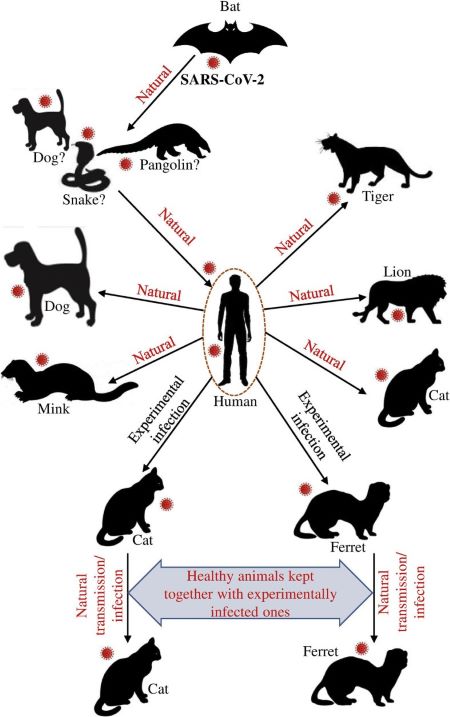Susceptible Animal Species and Animal Models for Coronavirus Research
For a given disease, such as COVID-19, researchers strive to develop animal models that mimic the human course of the disease. Animal models of human disease should have a route of infection, severity of disease, and morbidity and mortality levels that are similar to the human course of the disease.
Animals that are susceptible to or have been used as animal models to study SARS-CoV-2 include cat, ferret, fruit bat, hACE2 mouse, hamster, nonhuman primate, and tree shrew. Figure 1 illustrates the host range of SARS-CoV-2 and the animals susceptible to SARS-CoV-2 infection. Table 1 provides information and references on these animals.
Animal models that are susceptible to or have been used as animal models to study other coronaviruses include chicken, dog, duck, hACE2 mouse, hDPP4 mouse, lung-only mouse, and pig. Table 2 below provides information and references on these animals.

Figure 1. Host range of SARS-CoV-2 and animals susceptible to SARS-CoV-2. (From: Hossain MG, Javed A, Akter S, et al. SARS-CoV-2 host diversity: An update of natural infections and experimental evidence. J Microbiol Immunol Infect 2020;S1684-1182(20)30147-X. doi:10.1016/j.jmii.2020.06.006.)
Select References—Animal Models for Coronavirus Research
- Abdel-Moneim AS, Abdelwhab, EM. Evidence for SARS-CoV-2 infection of animal hosts. Pathogens 2020;9(7):E529. doi: 10.3390/pathogens9070529.
- Hossain MG, Javed A, Akter S, et al. SARS-CoV-2 host diversity: An update of natural infections and experimental evidence. J Microbiol Immunol Infect 2020;S1684-1182(20)30147-X. doi: 10.1016/j.jmii.2020.06.006.
- Lakdawala SS, Menachery VD. The search for a COVID-19 animal model. Science 2020;368(6494):942–3. doi: 10.1126/science.abc6141.
- Shi J, Wen Z, Zhong G, et al. Susceptibility of ferrets, cats, dogs, and other domesticated animals to SARS–coronavirus 2. Science 2020;368(6494):1016–20. doi: 10.1126/science.abb7015.
- Wu C, Zheng M, Yang Y, et al. In silico analysis of intermediate hosts and susceptible animals of SARS-CoV-2. ChemRxiv. doi: 10.26434/chemrxiv.12057996.v1.
- Song Z, Xu Y, Bao L, et al. From SARS to MERS, thrusting coronaviruses into the spotlight. Viruses 2019;11(1):59. doi: 10.3390/v11010059.
- Gretebeck LM, Subbarao K. Animal models for SARS and MERS coronaviruses. Curr Opin Virol 2015;13:123–9. doi: 10.1016/j.coviro.2015.06.009.



